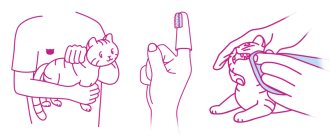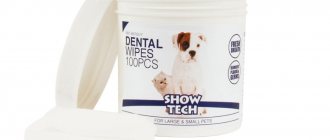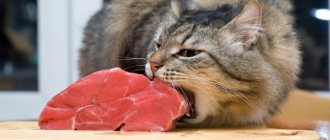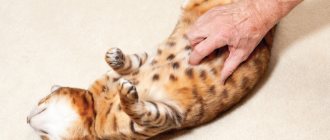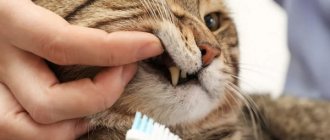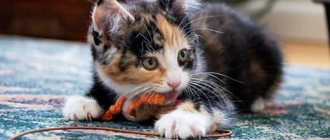What will you learn from the article?
- Does a cat need to brush its teeth?
- Why brush your cat's teeth?
- How to brush your cat's teeth How often should you brush?
- What you need for cleaning
- How to properly brush your cat's teeth at home
- At what age should cats be taught to brush their teeth?
- Alternative cleaning method
- Best Cleaning Products
Brushing your cat's teeth is the most effective way to reduce plaque, prevent tartar, and maintain long-term oral health. This procedure prevents many dental diseases and keeps the cat's breath fresh.
How to teach a kitten to brush its teeth? How correctly and how often should this be done? What means and tools should I use? You will find answers to all these questions in our article.
Do cats need to brush their teeth?
Is it possible to brush a cat's teeth? Need to! More than half of cats over 3 years old suffer from periodontal disease - inflammation of the tissues to which crowns are attached. It begins as gingivitis (inflammation of the gums) due to plaque accumulated on the teeth, where colonies of bacteria live. If plaque is not removed, tartar forms, creating a good environment for the development of microbes. In addition, the stone comes into contact with the gum, irritating it, causing inflammation. If the disease is neglected, the pet may lose teeth.
Other problems that may arise in cats if you decide that cats do not need to brush their teeth:
- caries;
- bleeding gums;
- bad breath;
- poor appetite;
- depressed mood;
- diseases of the digestive system due to putrefactive bacteria that came here from the oral cavity.
Of course, one could argue that wild cats have good teeth and don't need any cleaning. But their situation is different. They hunt and chew hard food, which allows them to clean the enamel of deposits. In addition, tough pieces of meat are less likely to get stuck in the teeth, while soft food, which is what indoor cats mostly eat, easily gets deposited between the crowns.
How often should you perform oral care for your pet?
How often to brush your teeth depends on their condition and the product used. There are drugs that prevent microorganisms and pieces of food from settling on the teeth, which remove odor from the mouth of cats and dogs. If toothpastes are used, then they are used 2-3 times a week, sometimes more often, and special professional gels for animals are used much less often - once a month.
In order for a pet to be healthy, every owner must take the time to perform this simple ritual - brushing its teeth, and then the pet’s playful mood will become a reward for its efforts.
How to brush your cat's teeth at home
To clean your cat's mouth, use a pet toothbrush. On sale are:
- a toothbrush with curved handles to make it easier to handle the mouth;
- brushes that fit comfortably in your hand;
- fingertips – brushes that fit onto the finger.
If you don’t have one, a child’s, very soft toothbrush will do. If you are unsure whether the appliance can be used, make sure the bristles fall just below the gum line. As a last resort, you can use gauze wrapped around your finger or a cotton swab.
How to clean a cat's teeth?
In veterinary stores and pet pharmacies you can buy toothpaste for cleaning cats' teeth. They contain substances that are harmless to her and a smell that she will like.
Can toothpaste be used on humans?
Human pastes cannot be taken. They contain substances that should not be swallowed, and while a person can resist the reflex movement, a cat cannot. Swallowing the paste may cause digestive upset.
Can you use baking soda for cleaning?
No. Baking soda contains a lot of alkaline, which if swallowed can upset the acid balance in the stomachs. In addition, the pet may not like the taste of the product, and it will vomit during the procedure.
Preparing the animal
Training a small animal is definitely easier than training an adult cat. In this regard, once the kitten is born, you should regularly set aside time for brushing your teeth.
Accustoming an adult pet to cleansing the mouth should be done gradually and correctly:
- You need to buy special hygiene products for the animal at the veterinary pharmacy. Human brushes and toothpaste are not suitable for cats, as they can damage gums and tooth enamel.
- Let your pet explore new items: sniff and examine. This will help him endure further teeth cleaning without panic.
- A few days before the procedure, you need to let the animal try the paste so that it is not frightened by new sensations.
- It is better to clean the oral cavity at a time when the cat has eaten and is about to sleep. At this moment, he will be as curious as possible, which can play in favor of the owner.
- If you have several pets living in an apartment, you will need to purchase an individual brush for each one to clean their mouth.
After completing the preliminary preparation, you can proceed to cleansing the oral cavity.
How to properly brush your cat's teeth
The manipulation should be carried out according to the following scheme:
- Apply a dental gel to your brush to clean your cat's teeth.
- Position your pet's head at a 45-degree angle and gently lift its lips. You don't have to open the cat's mouth.
- Concentrate first on cleaning the large back teeth and canines, where plaque builds up most often.
- Proceed slowly and carefully. If the bristles touch your gums, it can cause irritation.
- Don't worry if your pet won't open his mouth or let you brush the tips and inside of his teeth. Most damage affects the outer part of the crowns, the periodontium. In addition, a cat's tongue is better than a human's at removing tongue from the inside of crowns, reducing the need for cleaning them.
- Gradually clean all crowns.
- The average cleaning time is 30-60 seconds. from each side.
Take your time during the procedure. Your pet's teeth should be brushed slowly and carefully so as not to scare the animal. Be sure to praise him.
How to brush a cat's teeth with a fingertip
If you don’t have a brush, you can clean the cat’s mouth with a fingertip using the same method. Before starting the procedure, train the cat to place the owner's finger in the pet's mouth. To do this, you can do a gentle massage of the gums, smearing your finger with food tasty for the cat, allowing it to be sniffed and licked.
Additional information about tartar
Causes of stone formation?
- improper feeding of the predator with a predominance of soft food, which does not contribute to the natural cleansing of the surface of the teeth,
- improper feeding, which provokes a change in the acidity of the gastric contents with the appearance of belching, which, in turn, changes the acidity of saliva and provokes the formation of plaque and its petrification,
- malocclusion. Due to congenital or acquired after changing teeth, incorrect positioning of the teeth distorts their friction against each other and against the buccal surface, impairing self-cleaning,
- increased enamel roughness. Due to improper feeding, the smooth layer of tooth enamel is worn away,
- metabolic disease.
Under anesthesia or not?
It is almost impossible to remove tartar from cats without anesthesia using professional ultrasonic cleaning. In addition, the quality of the work done will be significantly impaired - there can be no talk of any thoroughness when the animal twists, kicks, tries to bite and practically does not allow anything to be done in the mouth area. Without anesthesia, it will not be possible to inspect the mouth and remove bad teeth.
But! Sometimes the situation may require the removal of tartar in cats without anesthesia, posing a threat to the life of the pet. Such situations include:
- allergic individuals, when the risk of an allergic reaction to anesthesia and anaphylactic shock is high,
- history of serious pathologies of the heart, central nervous system, liver and kidneys,
- individual intolerance to anesthesia components.
In such cases, tartar cleaning is carried out without the introduction of narcotic substances, in several stages and with enhanced fixation.
Predisposition
Tartar was once thought to be a problem in older cats. However, recently, age is not an indicator of health, so young animals may also have these dental problems. Moreover, yard cats, who are almost on pasture, almost never have problems with teeth, unlike decorative breeds of cats.
Most often affected:
- Persians,
- Scots and British,
- Siamese cats.
How to teach a kitten to brush its teeth
It is easiest to accustom a small kitten to the procedure. If the cat is an adult, the process may take longer. At first it will not be easy, but then the pet will get used to cleaning and will not pay attention to it.
To teach your kitten to brush, do this:
- Find a quiet, peaceful place where you can place your kitten. It is better to start training when the pet is on your lap, but you can put it on the table after laying down a towel. Make sure the door can be closed to block any escape route.
- Dip a cotton swab into the tuna liquid. Cats love the taste and it provides a good association with brushing their teeth.
- Raise the kitten's lips; you don't have to open your teeth.
- Rub the cotton swab onto your lips and the edges of your gums.
- The first few times, it is better to use a cotton swab to wipe a couple of crowns, not all of them, especially if the kitten is unsure and nervous.
- When your pet gets used to the procedure, you can start using the brush.
Let's go to the clinic
If the owner does not dare to carry out the procedure on his own or it has become obvious that the cat has already developed tartar, a visit to the veterinarian will be required. This is an expensive procedure; for the animal itself, it is most often associated with a stressful situation. You also need to take into account that there is a risk of falling into the hands of an inexperienced veterinarian, who can injure the gums and damage the enamel. Therefore, choosing a specialist must be approached responsibly and seriously.
Most often, clinics offer mechanical cleaning. It involves the use of special devices with several attachments. The cat receives local anesthesia and a mild sedative injection. The procedure is carried out quickly and painlessly.
If you have a choice, it is better to prefer ultrasonic cleaning. This is not only a more gentle technique for teeth, but also an opportunity to perfectly whiten darkened teeth. But this option is not suitable for “problem” cats – those with heart or vascular diseases.
Professional teeth cleaning for cats
Veterinarians recommend bringing your pet to the clinic once a year to evaluate the condition of the oral cavity. If the doctor detects inflammation or other problems with the gums, he will prescribe a medicine that will stop the disease in time.
Stones: what to do?
A timely examination by a veterinarian will help to detect and remove stones in time. If it forms, immediately go to the dentist. Remedies that offer to remove stones at home are ineffective. They can only prevent its occurrence, while solid formations must be removed by a specialist.
Cleaning stones on the teeth of cats can be done both with and without anesthesia. The second option is possible only if the pet behaves calmly and obediently opens its mouth.
In most cases, ultrasonic cleaning of cats' teeth is used. The procedure is expensive, but does not damage the enamel. Ultrasonic cleaning of a cat's teeth is carried out under anesthesia, since the cat may be frightened by the buzzing device or splashing water.
Before anesthesia, the doctor must carefully examine the pet and take tests to determine how it will tolerate the injection. This is especially important for kittens and older pets. The wrong dose can kill.
Caries: what to do?
Caries must be treated. Even if it doesn’t cause problems for your pet at first, sooner or later rotting will affect the roots, and then trouble will begin. Treatment of caries provides 2 options - crown removal and filling. The first is widespread, the second is possible only in advanced clinics and is expensive.
Scheme of the procedure
In order to learn how to brush a cat’s teeth at home, just read the following diagram:
- Take the animal in your arms, holding its paws. Brushing teeth is not the most pleasant procedure for cats, so it is best to do it together. One person holds the pet, and the second takes care of its oral hygiene.
- Gently pull back your pet's lips and open his mouth slightly.
- Use a soft, gentle circular motion to brush the cat's teeth, moving from the molars to the incisors. To achieve maximum results, it is recommended to hold the brush at an angle of 45 degrees relative to the tooth surface. For the first time, you can limit yourself to brushing only the front teeth, especially if the animal is nervous and restless.
- The optimal duration of the procedure is about 15–30 seconds. However, if teeth have not been brushed for a long time and your pet’s teeth are in poor condition, covered with plaque and tartar, it may take 1–2 minutes to get rid of them.
- After cleaning, it is necessary to wipe the animal’s gums and teeth with a piece of soft gauze treated in warm water.
After completing the procedure, the cat should definitely be praised and encouraged by treating it to something tasty.
Related articles:
Natural food for cats: pros and cons
How to maintain oral hygiene other than brushing?
There are special dry foods on sale for cleaning cats' teeth. They contain substances that prevent the appearance of stones. They also have a structure that allows mechanical cleaning of crowns.
You can buy treats for cats to clean their teeth, which your pets will happily chew on. Cat dental cleaning pads have a hard surface that cleans the canines. Their active components destroy plaque and kill bacteria.
For teeth, there are commercially available oral fluids. They have cleansing effects and eliminate unpleasant odors. You just need to add them to your drink. Manufacturers assure that the drug for cleaning teeth in cats is safe and does not affect the functioning of the digestive tract. As for users, opinions vary. Some helped, others had no effect, and others experienced vomiting and diarrhea.
Prevention of plaque and tartar formation
Tartar prevention is always more expedient and financially beneficial than regular cleaning, which primarily injures the cat’s nervous system.
The main preventive measures include:
- regular compliance with the rules of hygiene of the cat’s oral cavity, cleaning soft plaque,
- proper and balanced nutrition, lump feed, reducing the amount of soft food,
- monitoring the state of the gastrointestinal tract, timely treatment of emerging pathologies that change the acidity of the gastric environment and mouth,
- periodic introduction to the Murok diet of a special food containing polyphosphates that cover the teeth with a protective film that prevents the formation of plaque and stone.
Tips for cleaning your cat's mouth
- There are a lot of bacteria in a cat's mouth, so wear gloves during the procedure. If you cannot manipulate them, wash your hands thoroughly after finishing work.
- After the procedure, wash your toothbrush thoroughly.
- Change your cat's toothbrush every three months.
- If you have several pets, buy a separate cat hygiene product for each pet.
- Provide your cat with quality food. It has a good effect on the condition of teeth, making them resistant to decay.
- Before brushing, let your pet smell a sample of the paste. If he likes the smell, he will be more accommodating.
- Be sure to praise the cat during the procedure.
- If you can’t regularly remove plaque, buy treats - pads, teeth cleaning sticks for cats - by looking through the pet supplies catalog.
Useful tips
- There are a lot of bacteria in the animal's mouth, so it is recommended to wear gloves when brushing teeth;
- The toothbrush should be washed thoroughly after the procedure;
- The brush needs to be replaced every 3 months;
- If there are several cats in the house, then each one requires a separate brush;
- Animal feed must be of high quality;
- Before cleaning, you need to let the cat smell the paste;
- The procedure should be accompanied by praise.
If it is not possible to remove plaque regularly, then you can buy special treats - sticks, pads for cleaning cats' teeth.
Necessary tools and tools
There are several different ways to clean your cat's mouth. Depending on the technology used, suitable tools and means are selected. The standard set for the procedure is a special brush and toothpaste or gel.
You can purchase the necessary tools at pet stores. Brushes can vary in size and shape. massage finger pads and ones with bristles on sale However, this method is unsafe, since not all cats will allow you to touch their teeth with your fingers and may even bite.
It is allowed to use a toothbrush for children, as it has soft bristles and will not harm the cat’s gums. An alternative method of cleaning is to take a piece of soft cloth and wrap it around your index finger.
As for toothpastes for cats, unlike toothbrushes, they cannot be replaced by human means. This is due to the fact that animals do not spit out the paste and do not rinse their mouths after it. Therefore, products for people can harm the cat, even lead to poisoning.
In pet stores and veterinary clinics you can find pastes with aromas of various foods, such as meat and fish. The taste may attract the animal, making it easier to clean the enamel. Some cats categorically do not accept the mechanical method of cleaning enamel.
In this case, you can purchase a special liquid . It is diluted in water that is given to the pet to drink. The product contains special components that allow you to remove plaque from teeth and cleanse the oral cavity of bacteria. It is also recommended to include more solid foods in the animal’s menu.
From time to time you can give your pet chicken bones to chew on. Pet stores sell special treats that help remove plaque from tooth enamel, such as chew sticks.
You cannot use hard or sharp objects, such as toothpicks, to clean the mouth, as they can injure the animal.
Teeth whitening: indications
Throughout life, enamel is exposed to negative influences from external factors that can change its shade. Dyes contained in medicines and food, cigarettes and cosmetics are deposited on the surface of the tooth or even penetrate into the dentin. Sometimes, the color of tooth enamel may change due to tooth trauma or even during treatment. If these factors are present, it will be advisable to undergo a teeth whitening procedure.
Training kittens
The primary incisors erupt in kittens at two weeks of age. By 7-8 months, permanent teeth grow in; from this moment on, the young pet needs to be taught oral hygiene.
The kitten is gradually accustomed to the hygiene procedure. Feed by hand, trying to touch the fangs so that the kitten gets used to the presence of a finger in the mouth. Wrap your finger in a piece of cloth or a damp napkin and dip it in the meat broth. Let the kitten sniff the finger and examine it. Gently run your finger over the fangs.
The procedure is carried out daily, starting with cleaning the front incisors. The duration of the first treatments is 15-20 seconds. Gradually move the finger inside the mouth. Gently clean the fangs and gums, trying to avoid stress. After treatment, the kitten is rewarded with its favorite food. After 5-10 procedures, the kittens get used to it and are calm about the treatment.
Oral hygiene products
To clean canines, you should use toothbrushes and cleaning products specifically for cats. Toothbrushes and toothpastes cannot be used for people. Pastes are toxic to cats; large doses of fluoride can damage enamel.
The most commonly used brushes are finger brushes for animals, which come in bristly and massage types. The bristly ones are used to clean teeth and massage the gums. When cleaning, the brush is placed on your finger. The disadvantage of the device is the possibility of a frightened pet biting the owner’s finger during treatment. There are ordinary toothbrushes on sale, which differ from human ones in having a longer handle and short, soft bristles. In exceptional cases, use a baby brush with soft bristles.
Prophylactic and therapeutic toothpastes for cats are produced. Pastes for prevention are popular with additives that are pleasant for cats: the taste of beef, fish, chicken. Main ingredients: glycerin, triophosphate, carrageenan. The bone meal included in the composition helps to gently clean the teeth. Main brands: Beaphar, Trixie, Cliny.
Medicinal toothpastes are used as prescribed by a veterinarian. The duration of the course is determined by a specialist.
